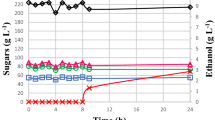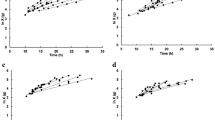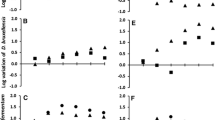Abstract
The yeast Dekkera bruxellensis plays an important role in industrial fermentation processes, either as a contaminant or as a fermenting yeast. In this study, an analysis has been conducted of the fermentation characteristics of several industrial D. bruxellensis strains collected from distilleries from the Southeast and Northeast of Brazil, compared with Saccharomyces cerevisiae. It was found that all the strains of D. bruxellensis showed a lower fermentative capacity as a result of inefficient sugar assimilation, especially sucrose, under anaerobiosis, which is called the Custer effect. In addition, most of the sugar consumed by D. bruxellensis seemed to be used for biomass production, as was observed by the increase of its cell population during the fermentation recycles. In mixed populations, the surplus of D. bruxellensis over S. cerevisiae population could not be attributed to organic acid production by the first yeast, as previously suggested. Moreover, both yeast species showed similar sensitivity to lactic and acetic acids and were equally resistant to ethanol, when added exogenously to the fermentation medium. Thus, the effects that lead to the employment of D. bruxellensis in an industrial process and its effects on the production of ethanol are multivariate. The difficulty of using this yeast for ethanol production is that it requires the elimination of the Custer effect to allow an increase in the assimilation of sugar under anaerobic conditions.





Similar content being viewed by others
References
Abbott DA, Hynes SH, Ingledew WM (2005) Growth rates of Dekkera/Brettanomyces yeasts hinder their ability to compete with Saccharomyces cerevisiae in batch corn mash fermentations. Appl Microbiol Biotechnol 66:641–647
Basílio ACM, Araújo PRL, Morais JOF, Silva-Filho EA, Morais MA Jr, Simões DA (2008) Detection and identification of wild yeast contaminants of the industrial fuel ethanol fermentation process. Curr Microbiol 56:322–326
Basso LC, de Amorim HV, de Oliveira AJ, Lopes ML (2008) Yeast selection for fuel ethanol production in Brazil. FEMS Yeast Res 8:1155–1163
Blomqvist J, Eberhard T, Schnürer J, Passoth V (2010) Fermentation characteristics of Dekkera bruxellensis strains. Appl Microbiol Biotechnol 87:1487–1497
Ciani M, Ferraro L (1997) Role of oxygen on acetic acid production by Brettanomyces/Dekkera in winemaking. J Sci Food Agric 75:489–495
Ciani M, Maccarelli F, Fatichenti F (2003) Growth and fermentation behaviour of Brettanomyces/Dekkera yeasts under different conditions of aerobiosis. World J Microbiol Biotechnol 19:419–422
De Miniac M (1989) Contamination des fermentations alcooliques industrielles par les levures du genre Brettanomyces. Ind Aliment Agric 106:559–563
De Barros Pita W, Leite FC, de Souza Liberal AT, Simões DA, de Morais MA (2011) The ability to use nitrate confers advantage to Dekkera bruxellensis over S. cerevisiae and can explain its adaptation to industrial fermentation processes. Antonie van Leeuwenhoek 100:99–107
Galafassi S, Merico A, Pizza F, Hellborg L, Molinari F, Piskur J, Compagno C (2010) Dekkera/Brettanomyces yeasts for ethanol prodution from renewable sources under oxygen-limited and low-pH conditions. J Ind Microbiol Biotechnol 38:1079–1088
Gerós H, Azevedo MM, Cássio F (2000) Biochemical studies on the production of acetic acid by the yeast Dekkera anomala. Food Technol Biotechnol 38:59–62
Lee SS, Robinson FM, Wang HY (1981) Rapid determination of yeast viability. Biotechnol Bioeng 11:641–649
Lema C, Garcia-Jares C, Orriols I, Angulo L (1996) Contribution of Saccharomyces and non-Saccharomyces populations to the production of some components of Albariño wine aroma. Am J Enol Viticult 47:206–216
Liberal ATS, Basílio ACM, Resende AM, Brasileiro BTRV, Silva-Filho EA, Morais JOF, Simões DA, Morais MA Jr (2007) Identification of Dekkera bruxellensis as a major contaminant yeast in continuous fuel ethanol fermentation. J Appl Microbiol 102:538–547
Oelofse A, Pretorius IS, du Toit M (2008) Significance of Brettanomyces and Dekkera during winemaking: a synoptic review. S Afr J Enol Vitic 29:128–144
Passoth V, Blomqvist J, Schnürer J (2007) Dekkera bruxellensis and Lactobacillus vini form a stable ethanol producing consortium in a commercial alcohol production process. Appl Environ Microbiol 73:4354–4356
Phowchinda O, Deliadupuy ML, Strehaiano P (1995) Effects of acetic acid on growth and fermentative activity of Saccharomyces cerevisiae. Biotechnol Lett 17:237–242
Renouf V, Falcou M, Miot-Sertier C, Perello MC, De Revel G, Lonvaud-Funel A (2006) Interactions between Brettanomyces bruxellensis and other yeast species during the initial stages of winemaking. J Appl Microbiol 100:1208–1219
Rozpędowska E, Hellborg L, Ishchuk OP, Orhan F, Galafassi S, Merico A, Woolfit M, Compagno C, Piskur J (2011) Parallel evolution of the make-accumulate-consume strategy in Saccharomyces and Dekkera yeasts. Nat Commun 2:302
Silva-Filho EA, Melo HF, Antunes DF, Dos Santos SKB, Resende MA, Simões DA, Morais MA Jr (2005) Isolation by genetics and physiological characteristics of a fuel ethanol fermentative Saccharomyces cerevisiae strain with potential for genetic manipulation. J Ind Microbiol Biotechnol 32:481–486
Uscanga MGA, Delia ML, Strehaiano P (2003) Brettanomyces bruxellensis: effect of oxygen on growth and acetic acid production. Appl Microbiol Biotechnol 61:157–162
Van Dijken JP, Scheffers WA (1984) Studies on alcoholic fermentation in yeasts. In: Houwink EH, Van der Meer RR (eds) Innovations in biotechnology. Elsevier, Amsterdam, pp 497–506
Wijsman MR, van Dijken JP, van Kleeff BH, Scheffers WA (1984) Inhibition of fermentation and growth in batch cultures of the yeast Brettanomyces intermedius upon a shift from aerobic to anaerobic conditions (Custers effect). Antonie Van Leeuwenhoek 50:183–192
Acknowledgments
The authors express their gratitude to Prof. Andreas Gombert, laboratory of Biochemistry Engineering at University of São Paulo, for the HPLC analysis, and the Brazilian funding agencies CNPq, FACEPE and FAPESP for sponsoring this study and providing financial support. This study is part of the activities being undertaken by the Bioethanol Research Network of the State of Pernambuco (CNPq-FACEPE/PRONEM).
Author information
Authors and Affiliations
Corresponding author
Rights and permissions
About this article
Cite this article
Pereira, L.F., Bassi, A.P.G., Avansini, S.H. et al. The physiological characteristics of the yeast Dekkera bruxellensis in fully fermentative conditions with cell recycling and in mixed cultures with Saccharomyces cerevisiae . Antonie van Leeuwenhoek 101, 529–539 (2012). https://doi.org/10.1007/s10482-011-9662-2
Received:
Accepted:
Published:
Issue Date:
DOI: https://doi.org/10.1007/s10482-011-9662-2




